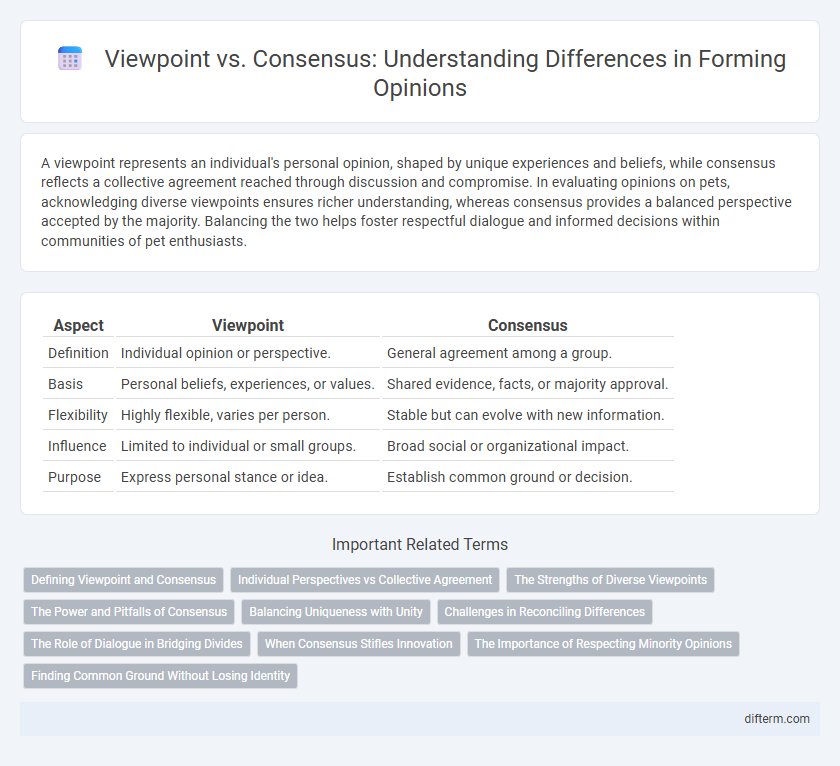A viewpoint represents an individual's personal opinion, shaped by unique experiences and beliefs, while consensus reflects a collective agreement reached through discussion and compromise. In evaluating opinions on pets, acknowledging diverse viewpoints ensures richer understanding, whereas consensus provides a balanced perspective accepted by the majority. Balancing the two helps foster respectful dialogue and informed decisions within communities of pet enthusiasts.
Table of Comparison
| Aspect | Viewpoint | Consensus |
|---|---|---|
| Definition | Individual opinion or perspective. | General agreement among a group. |
| Basis | Personal beliefs, experiences, or values. | Shared evidence, facts, or majority approval. |
| Flexibility | Highly flexible, varies per person. | Stable but can evolve with new information. |
| Influence | Limited to individual or small groups. | Broad social or organizational impact. |
| Purpose | Express personal stance or idea. | Establish common ground or decision. |
Defining Viewpoint and Consensus
A viewpoint represents an individual's personal perspective shaped by unique experiences and beliefs, reflecting subjective interpretation. Consensus emerges from collective agreement within a group, synthesizing multiple viewpoints into a unified stance that balances diversity and common ground. Understanding the distinction between viewpoint and consensus is essential for navigating discussions, decision-making, and conflict resolution effectively.
Individual Perspectives vs Collective Agreement
Individual perspectives offer unique insights shaped by personal experiences, enriching discussions with diverse viewpoints. Collective agreement, however, consolidates multiple opinions into a unified position, promoting cohesion and shared understanding. Balancing individual viewpoints with consensus ensures both innovation and collaborative decision-making in opinion formation.
The Strengths of Diverse Viewpoints
Diverse viewpoints enhance problem-solving by integrating multiple perspectives, which leads to more innovative and effective solutions. Exposure to contrasting opinions broadens understanding and mitigates groupthink, fostering critical thinking and adaptability. Teams embracing diversity in thought also benefit from increased creativity and resilience, crucial for navigating complex challenges.
The Power and Pitfalls of Consensus
Consensus harnesses collective intelligence to drive unified decisions and foster collaboration across diverse groups, often leading to widely accepted solutions. However, the pitfalls of consensus include groupthink, where critical analysis is suppressed, and the dilution of innovative ideas due to the pressure to conform. Balancing individual viewpoints with the strength of consensus is crucial to achieving effective and adaptable outcomes.
Balancing Uniqueness with Unity
Balancing uniqueness with unity requires valuing individual viewpoints while recognizing the strength of consensus in guiding collective decisions. Embracing diverse perspectives fosters innovation and critical thinking, yet consensus ensures stability and shared purpose within a group. Effective collaboration emerges from integrating distinct ideas with common goals, creating a dynamic equilibrium between originality and cohesion.
Challenges in Reconciling Differences
Reconciling differences between individual viewpoints and broader consensus often faces challenges rooted in diverse experiences and inherent cognitive biases. Strong personal convictions can hinder open dialogue, limiting the capacity to find common ground or integrate contrasting perspectives. Effective communication strategies and empathetic listening are essential to bridge gaps and foster collaborative decision-making despite conflicting opinions.
The Role of Dialogue in Bridging Divides
Dialogue acts as a crucial mechanism in bridging divides by allowing diverse viewpoints to be expressed and understood, fostering empathy and reducing polarization. Through open communication, individuals can move from entrenched opinions towards building a shared consensus that respects differing perspectives. Emphasizing active listening and mutual respect within dialogue promotes collaborative problem-solving and social cohesion.
When Consensus Stifles Innovation
Consensus often prioritizes conformity over creativity, limiting diverse perspectives that drive groundbreaking ideas. When groups settle on a single viewpoint, innovative solutions might be overlooked in favor of safe, widely accepted options. Challenging consensus can stimulate critical thinking and foster disruptive innovation essential for progress.
The Importance of Respecting Minority Opinions
Respecting minority opinions is essential for fostering diversity of thought and preventing groupthink within any decision-making process. Minority viewpoints often challenge the status quo, driving innovation and highlighting potential flaws overlooked by consensus. Valuing these perspectives strengthens democratic dialogue and promotes more inclusive, well-rounded outcomes.
Finding Common Ground Without Losing Identity
Balancing viewpoint and consensus requires recognizing the value of diverse perspectives while seeking shared values to foster collaboration. Emphasizing common goals enables groups to maintain individual identities without compromising core beliefs. Prioritizing respectful dialogue and mutual understanding cultivates unity that respects both consensus and unique viewpoints.
viewpoint vs consensus Infographic

 difterm.com
difterm.com